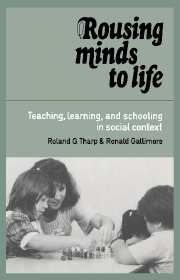Book contents
- Frontmatter
- Contents
- Acknowledgments
- Introduction
- Part I Teaching, schooling, and literacy: a unified theory of education
- Part II Practice
- 6 A school organized for teaching: the Kamehameha Elementary Education Program
- 7 The activity setting of the instructional conversation: developing word and discourse meaning
- 8 The orchestration of activity settings: learning and social interaction in the whole group and independent centers
- 9 The interpsychological plane of teacher training
- 10 Assisting teacher performance through the ZPD: a case study
- 11 The intrapsychological plane of teacher training: the internalization of higher-order teaching skills
- 12 The schools in mind and society
- References
- Author index
- Subject index
11 - The intrapsychological plane of teacher training: the internalization of higher-order teaching skills
Published online by Cambridge University Press: 05 June 2012
- Frontmatter
- Contents
- Acknowledgments
- Introduction
- Part I Teaching, schooling, and literacy: a unified theory of education
- Part II Practice
- 6 A school organized for teaching: the Kamehameha Elementary Education Program
- 7 The activity setting of the instructional conversation: developing word and discourse meaning
- 8 The orchestration of activity settings: learning and social interaction in the whole group and independent centers
- 9 The interpsychological plane of teacher training
- 10 Assisting teacher performance through the ZPD: a case study
- 11 The intrapsychological plane of teacher training: the internalization of higher-order teaching skills
- 12 The schools in mind and society
- References
- Author index
- Subject index
Summary
The theory of education developed in this volume sets a demanding standard for teachers: Teaching occurs only when assisted performance is provided to the learner in the ZPD. To achieve this ideal requires, of those who would be teachers, a transformation of mind. This transformation consists in the development of new, higher-order cognitive processes, new values, and new motives and is achieved by the same psychosocial processes that we have detailed in discussing the developmental progression that occurs in children.
The stages of development of higher-order teaching skills
The developmental progression of a performance capacity, for people of all ages, can be conceptualized in four stages, as described in Chapter 2 (Tharp, Gallimore, & Calkins, 1984; Watson & Tharp, 1985; Wertsch, 1979, 1985b). These developmental progressions have been studied mostly in children (Berk & Garvin, 1984; Rogoff & Gardener, 1984; Tharp, Gallimore, & Calkins, 1984; Wertsch, 1979), but can also be seen in adults during skill acquisition (Gallimore et al., 1986; Watson & Tharp, 1985). In this chapter, we use the theory to illuminate the development of higher-order teaching skills.
In Stage I, teacher behavior is regulated by more capable others in social transactions. In Stage II, it is regulated by self-directed speech and other forms of self-directed assistance by the learner. In Stage III, self-directed speech goes “underground,” becomes silent, rapid, and shorthand, and disappears as performance becomes internalized, automatized, smooth, and integrated.
- Type
- Chapter
- Information
- Rousing Minds to LifeTeaching, Learning, and Schooling in Social Context, pp. 249 - 265Publisher: Cambridge University PressPrint publication year: 1989



